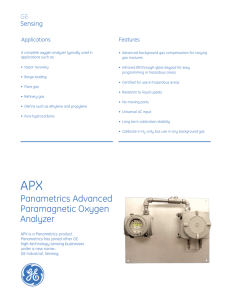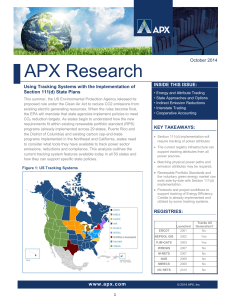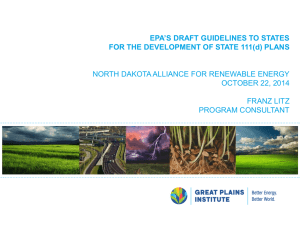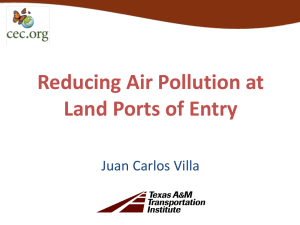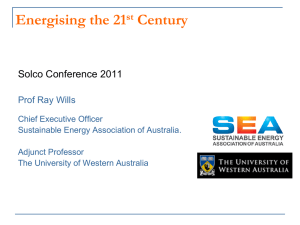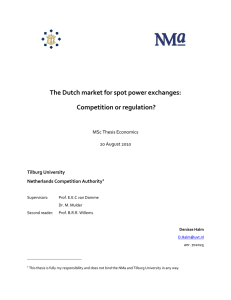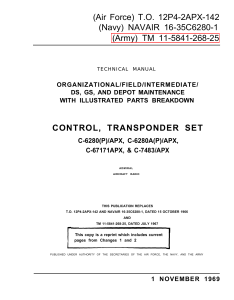It`s All in the Numbers: Options for State and Regional Compliance
advertisement
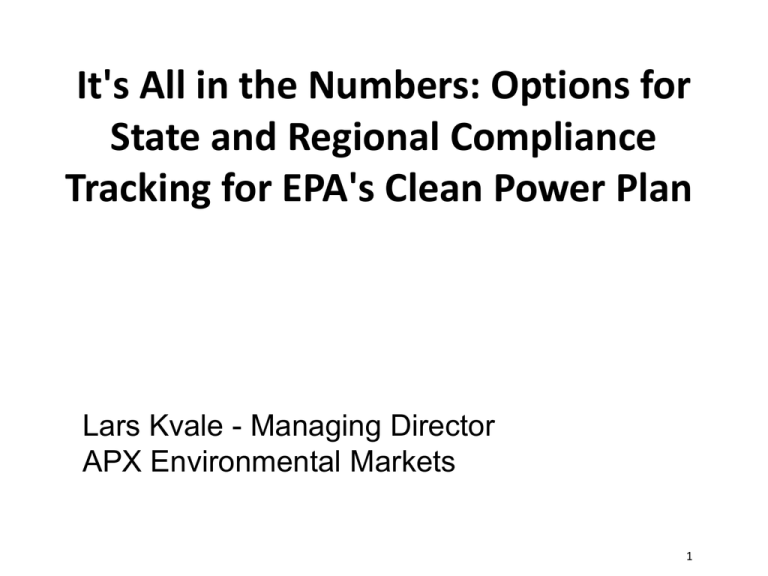
It's All in the Numbers: Options for State and Regional Compliance Tracking for EPA's Clean Power Plan Lars Kvale - Managing Director APX Environmental Markets 1 It's All in the Numbers: Options for State and Regional Compliance Tracking for EPA's Clean Power Plan NARUC Annual Meeting 2014 Lars Kvale, APX, Inc. Clean Air Act Renewable Portfolio Standards, Registries and RECs Section 111(d), Renewable Attributes and Energy Efficiency Existing Registry Elements & Section 111(d) Implementation Options Further Thoughts and Questions --- Disclaimer: The information in this presentation is based upon an analysis of the Proposed EPA Rules and data displayed on publicly available reports. APX, Inc. works with tracking systems across the United States but the statements in this analysis presents APX’s analysis and not those of any of the registries or organizations we work with. Finally, as the process moves forward it is likely that the EPA rules and interpretations of their intent will change. As this occurs APX will continue to support its clients with updated analyses. Copyright APX, Inc. © 2014 Renewable Energy Registries Copyright APX, Inc. © 2014 Power Markets Copyright APX, Inc. © 2014 Energy, RECs and Renewable Portfolio Standards RPS Markets REC Voluntary Markets Energy (Null Power) Power Markets (ISOs) RECs (generally) include environmental attributes but how are they defined? -Carbon? -Other Pollutants? -Other Benefits? Copyright APX, Inc. © 2014 Clean Air Act (from Nixon to Obama) 1970: Passage of Muskie Bill (i.e. The Clean Air Act) 1990: Institution of Acid Rain Cap-and-Trade Program CAA Title I – Provisions for Attainment and Maintenance of NAAQS Six Criteria Air Pollutants: Particulate Matter, Sulfur Dioxide, Nitrogen Dioxide, Carbon Monoxide, Ozone, Lead SIP Implementation of SOx Scrubbers, NOx Selective/Non-Selective Catalytic Reduction Units, and Particulate Baghouses and Electrostatic Precipitators (40 CFR Part 52) 2012: § 111(b) – Emission Performance Standards for New, Modified, and Reconstructed Power Plants 2014: § 111(d) – Emission Performance Guidelines for Existing Power Plants Plans, Pollutants, Facilities Flexible Standards for State Compliance via Market-Based Incentive Mechanisms and RPS/EERS Programs • Options: Portfolio Strategies, Regional Greenhouse Gas Initiative, Equivalency Pathway o June 1, 2014: Proposed Rule Deadline o June 1, 2015: Final Rule Deadline o June 30, 2016: Initial SIPs Deadline o June 30, 2017: Final SIPs Deadline o June 30, 2018: Final SIPs Deadline for Multi-State Collaboration Participants Copyright APX, Inc. © 2014 CAA §111(d): Clean Power Plan Proposal to regulate GHG emissions from fossil fuel-fired Generating Units (EGUs) in the form of state implementation plans This proposal does not directly regulate EGU emissions but instead, the EPA is proposing statewide CO2 emission goals and guidelines, i.e. setting CO2 emission intensity targets for the power sector for each state. Establishes standard of performance for any existing source, whereby the EPA must determine the best system of emissions reduction (BSER) adequately demonstrated. By 2030, EPA expects this proposed rule to achieve 30% CO2 emissions reduction from estimated 2005 CO2 emissions from power sector. This is not an absolute target, but rather the EPA expects emissions to be reduced by 30% if all States comply with their emissions intensity target. Copyright APX, Inc. © 2014 Baselines: EPA calculated baselines for each state Emission Targets: -State specific set by EPA based on current policies and available options for reducing emissions -Rate based (lbs./MWh) or mass Based (lbs.) Building Blocks: 1) Plant Efficiency Improvements 2) Re-dispatch Existing NGCC Power Sources 3) Renewable Energy Generation 4) Demand-Side Energy Efficiency EPA’s Approach to RECs and RPS Markets EPA defines that the attributes/greenhouse gas reductions caused by renewable energy belong to the owner of the RECs Therefore states may claim CO2 emissions reductions regardless of location How can this be accounted for in power markets that span several states? What if neighboring states choose different implementation options (rate vs mass-based)? What about the emission liabilities from emitting resources exporting power? Not all RECs are created equal Copyright APX, Inc. © 2014 REGISTRY ELEMENT Tracking emissions attributes for every MWh generated Calculation of average and residual system emission rates SUPPORTS: Allocation of emission liabilities for purchased power Tagging emission attributes from source to sink Interaction with other regional power markets and the attribution of emission characteristics to power imports and exports The ability to set-up a state market that does not align with regional power market borders Guarantees that attributes are not double-counted between regions Enables allowance adjustments whether for green power markets or RPS compliance results Allocation of emission liabilities for purchased power Applying emission attribute to imported and exported power Tracking Energy Efficiency savings The inclusion of energy efficiency certificates in tradable markets Calculation and tracking of emission The inclusion of energy efficiency and renewable energy reductions from RE & EE to adjust emission rates Tracking inter-state power transactions Inter-registry Import and Exports Support carbon allowance adjustment based on voluntary green power Public Reports Provides transparency to all stakeholders Implementation Scenarios Interstate Trading Solutions Option Advantages Structure regional programs Simplifies accounting and that correspond to power power market transactions region boundaries Rely on GHG restrictions being implemented equally across States Does not reflect physical power flows which could contribute to other issues Track intra-region Most accurate accounting transactions and match with as the attributes reflect the attributes physical transactions Rely on all generation tracking for emissions liabilities and performance If all states within a power region follow this approach all emission liabilities will be accounted for Disadvantages Not necessarily a feasible option for most states as they are participating in more than one region States could implement rules on varying timetables providing unequal market conditions Requires work to better understand and compute intra-region power flows Some states participate in more than one power region Complexity The challenge of integrating Section 111(d) State Implementation plans with: RPS Cap-and-trade Regional power markets Electricity regulation Energy efficiency initiatives (Renewable) Power attribute markets. All States (except Hawaii) are involved in cross-state REC markets Power regions cut across state lines (ISOs, sub eGRID regions, power pools) Indirect vs Direct Emissions More info: http://www.apx.com/2014/10/27/apx-research-section-111dtracking-systems/ Lars Kvale, lkvale@apx.com , 240-568-8976 www.apx.com Copyright APX, Inc. © 2014
